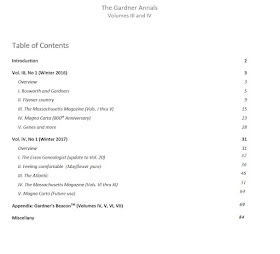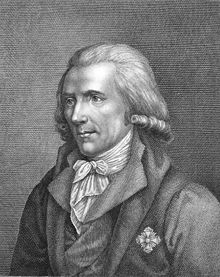Until a few days ago, we thought that we were the only defenders of Nathaniel Eaton. Along that line, we, recently, did a post on
Nathaniel Eaton and noted his academic accomplishments which were substantial. Yet, he is vilified via Harvard's view related to tales told. Or, so it seems to go. Too, notice that we remark, in the post, about Dr. Frank's ignoring this subject.
Then, very recently, we were contacted by David Danielson Eaton who is a descendant of Nathaniel and is member of
The Eaton Families Association (EFA). This group has been at it since 1884 and so will be of interest. Too, they have a connection with descendants of
Theophilus Eaton. He was the brother of Nathaniel. We got an update to
Nathaniel's Wikipedia page.
As an aside, as the Gardner Research article (next) was being prepared, the Eaton group was writing about Nathaniel (newsletters for members only). We have a copy of an article published by the EFA in defense of Nathaniel (Barbara Fitzsenry
The 'New' Etonian (June 2015) "A Discussion of Nathaniel Eaton's Reputation as Seen by History").
This article was not seen prior to the Gardner Research article about Dr. Frank being a descendant: TGA Vol. II, No. I "
Benjamin Brown Gardner (and Nathaniel Eaton)" which was published too in TEG 35:1. In our article, we commented that Nathaniel's experience at Harvard needs another look; there have been many posts alluding to this theme.
In a coming TGA, we will reprint parts of the EFA paper. Too, though, we learned that the Gardner Research article had been referenced in an Eaton article in The American Genealogist (see image).
As an aside, many early writers noted that Anna, the daughter of Benoni who was a son of Nathaniel, died young. But, we referenced the notion of H.H. Crapo and the Knapp family that Anna married and had offspring. Too, we have this excerpt from a New Haven meeting in which Anna's information is corrected in pencil:
The family of Nathaniel Eaton (at the Boston Library, available via archive.org).
No doubt, there is a lot to the stories and their provenances. But, it will be good to have Nathaniel get another hearing. Expect this theme to be continued in the near future.
One motivation. This may have been an early witch hunt. Dr. Frank's ancestors can tell us of that. As well, the whole theme applies to today (various ways). To us, it is another example of New England's long reach.
---
Note (01/06/2022 - see Remarks, this day, for the motivation for the addendum) -- We have seen two The Harvard Crimson (thecrimson.com) that were dated 2014 and 2019. We never thought to check further as there were plenty of other fish (gutted?) to fry. Too, we were confirming information about Benoni and lots of other persons of that time and place. Imagine Benoni's life, in Cambridge after his father left first, then his family (who were shipwrecked?). Whatever the tales, the phenomenal aspects are our main interest. But, to be complete, we did a search and found these tales, from the past:
23 September 1940,
5 November 1940,
10 December 1949,
25 September 1979, and
14 February 2007. There are many more links listed by Google to a specific query (the harvard crimson - eaton - pudding - dung); it would be interesting to extend this research (future grant). At least one mentioned the PhD and MD degrees, later extended. There wasn't much on Eaton's Virginia time with a supposed new family. On the other hand, the tale is there. Let's leave this, for now - see Richard Norton Smith's
The Harvard Century: The Making of a University to a Nation (1998) and Elizabeth Tucker's
Campus Legends: A Handbook (2005) (quote: Goat's dung and mackerel guts rival modern "fast food" legends in the degree of disgust that they inspire. From this account and others, it seems clear that America's first college students enjoyed telling stories that highlighted -- and probably exaggerated -- the most shocking details of their miserable meals at college) which can be previewed.
Remarks: Modified: 01/06/2022
08/03/2017 --
What is the coolest obscure history fact you know? This question, on Quora, seemed a good place to present some of research findings. Nathaniel's experience is first, since the answer deals with Harvard and its roles. Not to condone bad behavior, however we need to look at this from Nathaniel's side, too. He was highly educated before coming over here. He met up with uncouth youth of the colonies. Now, here is an issue. Do you realize how Captains on ships treated their measly sailors? Not well. One might say torture. Too, slavery has been the norm for mankind for a very long time. Seems to sit well with some cultures, even today, that is, misbehavior there on the part of slavers, of several type. Incidentally, look at how the Puritans handled their misfits. Say, Quakers? The look from now to then, seemingly celebrated each year at the esteemed institution, is (has been) one-sided.
08/09/2017 --
In the School of Tyrannus (2014). Left this comment (Some of the 'apologies' (see latest updates on the Wikipedia page for Nathaniel) may have come from descendants (via Benoni who was left in Cambridge). Over the years, several have researched the matter which, to me (an outsider, and in-law, and johnny-come-lately), does need another look. See
thomasgardnerofsalem for an overview.) on the page. There needs to be an engaged discourse.
08/06/2018 -- Added
Benoni Eaton, son of Nathaniel Eaton and father of Anna (Eaton) Knapp to WikiTree.
09/27/2018 --
Nathaniel Eaton in the U.S. Christian Encyclopedia.
02/28/2019 -- Corrected a typo.

























